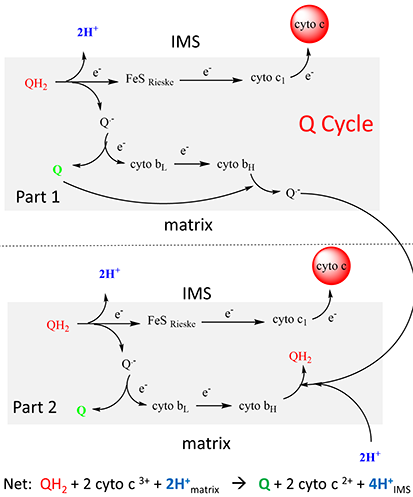Complex III:
Coenzyme
C/Cytochrome C Reductase
Java version
HTML 5 version (does not require Java; downloads and moves
slowly)
I. Introduction
Complex III accepts 4 electrons from 2reduced ubiquione, UQH2, and donates them to oxidized cytochrome
C. In the process it pumps 4H+s to the inner membrane space. A
variety of electron carriers in the complex, including hemes and an FeS Rieske
cluster, mediate electron flow.
For more information see
Biochemistry Online: Chapter 8C-6 - Complex III
II. General Structure
Electron flow occurs from mobile but lipophilic reduced UQH2 to mobile but
soluble cytochrome C in single electron steps. At the same time, the two
protons from the UQH2 are moved to the inner membrane space of the mitochondria.
These process are repeated twice, using 2 UQH2s, in a process
called the Q cycle.

Cartoon of Complex III without electron carriers
Now let's sequentially add the bound electron carriers which receive electrons from the mobile lipophilic UQH2 donor and deliver it to the mobile
soluble receiver, cytochrome C
add the Rieske Fe
2S
2 Centers
add hemes from cytochrome C1
add low potential hemes from cytochrome b
562 (cyto b
L)
add high potential hemes from cytochrome b
566 (cyto b
H)
add cytochrome C - the soluble mobile electron carrier with its own heme
Note the proximity of cytochrome c1 to cytochrome C implicates the c1 heme as the electron donor to the heme in cytochrome C.
add stigmatellin A (green spacefill), an inhibitor of UQH
2 transfer of electrons. It presumably shows the binding site for UQH
2. Note its proximal location to the Rieske FeS center and to the low potential heme of cytochrome b
562 .
This supports the Q cycle in that ubiquinone is in position to interact with both teh FeS Rieske centers and the low potential heme of cytochrome b562.